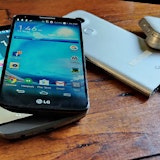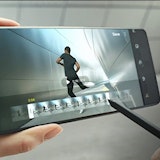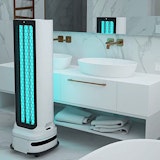By
Alex Angove
Last updated
 In 2013, smartphones are all about the features. HTC has Boomsound, Blinkfeed and the Zoe camera, while Samsung has a plethora of S-branded apps, including a health monitor and universal TV remote. Meanwhile, we've seen mostly incremental changes in hardware, with slightly faster processors, bumps in RAM and larger screens.
You definitely get the feeling that the big-name phone makers are treading water waiting for tech advancements. A few years ago there were big tech problems to solve. Smartphone user interfaces were jerky, slow and boring to look at, so they created more powerful hardware and larger capacity batteries to power it all. Even mobile broadband is going through a massive change in the form of 4G LTE networks which are typically faster than fixed line broadband speeds.
As consumer demands are met our priorities change. In the past it was hardware, this year it’s features.
What’s next?
We think it’s durability. Once features and UI have been dealt with durability is the next logical problem to tackle. Obviously hardware, features, UIs, cameras and all that other jazz will never stop evolving with new technology and market demands, but like we said earlier they can take a back seat for a while.
In 2013, smartphones are all about the features. HTC has Boomsound, Blinkfeed and the Zoe camera, while Samsung has a plethora of S-branded apps, including a health monitor and universal TV remote. Meanwhile, we've seen mostly incremental changes in hardware, with slightly faster processors, bumps in RAM and larger screens.
You definitely get the feeling that the big-name phone makers are treading water waiting for tech advancements. A few years ago there were big tech problems to solve. Smartphone user interfaces were jerky, slow and boring to look at, so they created more powerful hardware and larger capacity batteries to power it all. Even mobile broadband is going through a massive change in the form of 4G LTE networks which are typically faster than fixed line broadband speeds.
As consumer demands are met our priorities change. In the past it was hardware, this year it’s features.
What’s next?
We think it’s durability. Once features and UI have been dealt with durability is the next logical problem to tackle. Obviously hardware, features, UIs, cameras and all that other jazz will never stop evolving with new technology and market demands, but like we said earlier they can take a back seat for a while.
The Coming Age of Durability
You don’t have to search hard to find demonstrations dedicated to the ease at which a GS4 will shatter on contact with the pavement. It's no surprise then that rumors about ‘indestructible screens’ are resurfacing. These rumors about bendable, shatter-proof displays that are ‘coming soon’ have been around for a long time, and have been slowly gaining momentum every year as LG and Samsung show off how far their respective research has come. Of course, tech rumors are notoriously unreliable and usually reflect nothing more than wishful thinking; but not so with bendy screens. Last month, according to BGR and The Wall Street Journal, Yoon Bu-hyun, VP of LG Mobile, confirmed that the company would be launching a phone with a flexible OLED display before the end of 2013. Just a couple of days ago LG went further, announcing its plans to show off a 5-inch bendable and ‘unbreakable’ OLED display at the Society for Information Display (SID) trade show. Admittedly, expecting a device with a shatter-proof display sometime this year still feels a bit on the hopeful side. But if LG’s demo is up to scratch then there’s no reason we won’t see the next generation of high-enders start to sport this kind of thing.Flexible OLED Challenges
OLED (organic light-emitting diode) technology relies on light-emitting organic materials. These materials can be adhered to a transparent surface, after which they can function as a regular display. Of course the overall concept is a bit more complex, but this is the basic principle. Among the many benefits of OLED technology is that it is flexible. Thus an OLED display is really only limited by what kind of transparent surface it’s been adhered to and not by the light and image-generating tech doing all the work. Image Credit: The Verge
The biggest issue facing flexible OLED tech right now is the adherence process itself. Currently the main method being employed by Samsung, LG and other OLED TV manufacturers requires a lot of heat. So much heat that any flexible plastics that could be used as a display melt or warp as a result, leaving glass and more rigid, brittle polymers as the only alternative.
In the past few years LG and Samsung have been having success with new methods to adhere the OLED tech to bendy panels, but the process is often time consuming, making it both expensive and untenable from a mass-production viewpoint.
As more research is poured in to OLED new methods are discovered and old ones become more refined. If LG has truly discovered a fast and affordable method of OLED-to-flexible material application then that would be a huge step towards providing consumer-level bendy screens.
Image Credit: The Verge
The biggest issue facing flexible OLED tech right now is the adherence process itself. Currently the main method being employed by Samsung, LG and other OLED TV manufacturers requires a lot of heat. So much heat that any flexible plastics that could be used as a display melt or warp as a result, leaving glass and more rigid, brittle polymers as the only alternative.
In the past few years LG and Samsung have been having success with new methods to adhere the OLED tech to bendy panels, but the process is often time consuming, making it both expensive and untenable from a mass-production viewpoint.
As more research is poured in to OLED new methods are discovered and old ones become more refined. If LG has truly discovered a fast and affordable method of OLED-to-flexible material application then that would be a huge step towards providing consumer-level bendy screens.
Free the Designers!
Not only would a shatter-proof screen mean great impact resistance, said durability would allow for devices with minuscule bezels. Or no bezels. Bezels aren’t just there due to hardware restrictions; they also serve as a protective buffer that can absorb much of the shock from an impact before passing it on to the more fragile display. Removing the protective component frees up designers significantly. As far as the engineering restrictions of bezels go (specifically, it’s difficult to make a screen without them), a bendable screen would be able to bend its bezels around the edge, freeing up the entire front of the device for the usable part of the screen. There you have it: an edge-to-edge display that is immune to shattering and that presents few engineering problems for the designer. At least in a perfect world. Not being engineers ourselves there’s bound to be obstacles that we haven’t or couldn’t consider, but at the very least it’s possible, if not plausible. One more piece of great news for the designers lies in the thinness of OLED displays. Traditional displays always require a light source to be situated behind the image-creating panel. For example, a little-known fact is that an LED display is just an LCD display that is lit by light-emitting diodes (LEDs) instead of by CCFL or another kind of light source. OLED displays create their own light, totally eliminating the need for this secondary source. As such they can be much thinner than any other display on the market; quite literally almost paper-thin, while still providing great images and even better contrast than an LED alternative. A tonne of development already goes in to making smartphones as thin as possible. This benefit alone would be enough to get designers on board. As a bi-product of producing their own light, OLED displays also boast unparalleled viewing angles and astounding energy efficiency. In short, OLED tech is a shoe-in to be the next big thing, once manufacturers can make it a bit more affordable.Sony Almost Had It
 Sony has already taken a step in the direction of durability, albeit with limited success. The Sony Xperia Z and Xperia ZR are two such examples: two high-end smartphones built around water resistance, rather than screen durability.
More than resistant, the Xperia ZR can record HD video underwater -- a first for smartphones; albeit one with a niche appeal. What’s far more likely to grab the attention of the masses is ‘if you drop this phone in the toilet it won’t break’ or ‘fall in a pool with this in your pocket and everything will be fine’.
A water resistant phone addresses a real and common issue that people face with smartphones, and yet, the Xperia Z is experiencing far less popularity than the One and Galaxy S4. Why is that?
There are a multitude of reasons you can point to. Sony's 1080p display, while impressive, doesn't stand up to the quality of the screens in the One and GS4. Similarly, it has a 13-megapixel camera, but it lacks the bells and whistles of the competition, like HTC's Zoe camera features, or Samsung's Action Shots. At the end of the day, it could come down to who has more money to spend on billboard space and TV adverts.
Overall Sony was thinking in the right direction, but not at the right time. Once the new software features; 1080p screens and better cameras are out of the way; it’ll be time to focus on enhancing durability. But in the meantime what’s the point in grabbing a high-end durable device if it’s not really ‘high end’ in terms of user experience?
Sony has already taken a step in the direction of durability, albeit with limited success. The Sony Xperia Z and Xperia ZR are two such examples: two high-end smartphones built around water resistance, rather than screen durability.
More than resistant, the Xperia ZR can record HD video underwater -- a first for smartphones; albeit one with a niche appeal. What’s far more likely to grab the attention of the masses is ‘if you drop this phone in the toilet it won’t break’ or ‘fall in a pool with this in your pocket and everything will be fine’.
A water resistant phone addresses a real and common issue that people face with smartphones, and yet, the Xperia Z is experiencing far less popularity than the One and Galaxy S4. Why is that?
There are a multitude of reasons you can point to. Sony's 1080p display, while impressive, doesn't stand up to the quality of the screens in the One and GS4. Similarly, it has a 13-megapixel camera, but it lacks the bells and whistles of the competition, like HTC's Zoe camera features, or Samsung's Action Shots. At the end of the day, it could come down to who has more money to spend on billboard space and TV adverts.
Overall Sony was thinking in the right direction, but not at the right time. Once the new software features; 1080p screens and better cameras are out of the way; it’ll be time to focus on enhancing durability. But in the meantime what’s the point in grabbing a high-end durable device if it’s not really ‘high end’ in terms of user experience?
When Can We Have One?
It all depends on how cheaply and how well LG, Samsung and the other screen makers can manufacture this new breed of display. They’ve been on their way for a long time now, showing improvements with every passing year. In fact, they’ve been ‘on their way’ for so long that without this LG announcement we would have figured consumer-level application two or three years off at least. Even with the announcement things are less than certain; manufacturers are renowned for grandiose deadlines that run months, sometimes years overdue. If the technology is viable we expect to see it pick up momentum next year in 2014, with a prototype or two at the end of this calendar year. As we’ve pointed out, market trends follow the demands of customers. Demands are often based on problems that need fixing, rather than new cool stuff that people want to play with. Screen durability has needed attention for a long time, but plausible solutions are only just now surfacing. We can see no reason for manufacturers to back away from this opportunity. At this point in the game no one can deny that smartphone breakages are an issue; we just haven’t really had a viable solution yet. Sturdy phones always end up being a bit too chunky. The lack of inherent style relegates them to the realm of mid-to-low end devices. But a shatter-proof screen coupled with Sony’s approach to water-resistance that could feature on a flagship device would definitely turn a head or two for the first, second or even third company that can get theirs out on shelves. Especially if said screen is the thinnest, lightest and most energy-efficient on the market. Image Source: The VergeRelated Articles
Find Better Phones and Plans
Hundreds of cell phone plans unpacked. All the facts. No surprises.
Latest Cell Phone Deals
Latest Cell Phone News



































